NASA's Voyager 1 sends readable message to Earth after 4 nail-biting months of gibberish
After four months of being unable to detect comprehensible data from the Voyager 1 spacecraft, NASA scientists have had fresh luck after sending a "poke."

After a nail-biting four months, NASA has finally received a comprehensible signal from its Voyager 1 spacecraft.
Since November 2023, the almost-50-year-old spacecraft has been experiencing trouble with its onboard computers. Although Voyager 1, one of NASA's longest-lived space missions, has been sending a steady radio signal to Earth, it hasn't contained any usable data , which has perplexed scientists.
Now, in response to a command prompt, or "poke," sent from Earth on March 1, NASA has received a new signal from Voyager 1 that engineers have been able to decode. Mission scientists hope this information may help them explain the spacecraft's recent communication problems.
"The source of the issue appears to be with one of three onboard computers, the flight data subsystem (FDS), which is responsible for packaging the science and engineering data before it's sent to Earth by the telemetry modulation unit," NASA said in a blog post Wednesday (March 13) .
Related: NASA's 46-year-old Voyager 1 probe is no longer transmitting data
On March 1, as part of efforts to find a solution to Voyager 1's computer issues, NASA sent a command to the FDS on the spacecraft, instructing it to use different sequences in its software package, which would effectively mean skirting around any data that may be corrupted.
Voyager 1 is more than 15 billion miles (24 billion kilometers) from Earth. This means any radio signals sent from our planet take 22.5 hours to reach the spacecraft, with any response taking the same time to be picked up by antennas on Earth.

Sign up for the Live Science daily newsletter now
Get the world’s most fascinating discoveries delivered straight to your inbox.
On March 3, NASA detected activity from one section of the FDS that differed from the "unreadable data stream" they'd previously been receiving. Four days later, engineers started the heavy task of trying to decode this signal. By March 10, the team discovered that the signal contained a readout of the entire FDS memory. This included the instructions for what the FDS needed to do, any values in its code that can be changed depending on commands from NASA or the spacecraft's status, and downloadable science or engineering data.
Voyager 1 has ventured farther from Earth than any other human-made object . It was launched in 1977, within weeks of its twin spacecraft , Voyager 2. The initial aim of the mission was to explore Jupiter and Saturn . Yet after almost five decades, and with countless discoveries under their belts, the mission continues beyond the boundaries of the solar system .
— NASA hears 'heartbeat' signal from Voyager 2 probe a week after losing contact
— Historic space photo of the week: Voyager 2 spies a storm on Saturn 42 years ago
— NASA reestablishes full contact with Voyager 2 probe after nail-biting 2-week blackout
NASA scientists will now "compare this readout to the one that came down before the issue arose and look for discrepancies in the code and the variables to potentially find the source of the ongoing issue," they said in the blog post.
However, NASA stressed that it will take time to determine if any of the insights gained from this new signal can be used to solve Voyager 1's long-standing communication issues.

Emily is a health news writer based in London, United Kingdom. She holds a bachelor's degree in biology from Durham University and a master's degree in clinical and therapeutic neuroscience from Oxford University. She has worked in science communication, medical writing and as a local news reporter while undertaking journalism training. In 2018, she was named one of MHP Communications' 30 journalists to watch under 30. ( [email protected] )
NASA engineers discover why Voyager 1 is sending a stream of gibberish from outside our solar system
The moon is getting its own time zone, White House memo to NASA reveals
Pregnancy may speed up 'biological aging,' study suggests
- Bruzote I have an inside source who says the message said, "Be sure to drink your Ovaltine." Reply
- Grumpy-DC I love Ovaltine. Both flavors. And I remember "Captain Midnight" sponsored by same. Reply
Grumpy-DC said: I love Ovaltine. Both flavors. And I remember "Captain Midnight" sponsored by same.
- View All 3 Comments
Most Popular
By Sascha Pare April 08, 2024
By Andre Luiz Saraiva De Oliveira, Andrew Dzurak April 08, 2024
By Harry Baker April 08, 2024
By Kristina Killgrove April 08, 2024
By Tom Metcalfe April 07, 2024
By Nicoletta Lanese April 07, 2024
By Abha Jain April 07, 2024
By Jennifer Nalewicki April 07, 2024
By Jamie Carter April 06, 2024
By Melissa Hobson April 06, 2024
By Jennifer Nalewicki April 06, 2024
- 2 Watch live! The total solar eclipse has begun over North America.
- 3 April 8 solar eclipse: What time does totality start in every state?
- 4 Where to get solar eclipse glasses last minute
- 5 How and where to watch the April 8 solar eclipse online for free
- 2 Giant 'toe biter' water bugs discovered in Cyprus for the 1st time
- 3 When is the next total solar eclipse after 2024 in North America?
- 4 Watch live! The total solar eclipse has begun over North America.
- 5 8,200-year-old campsite of 'Paleo-Archaic' peoples discovered on US Air Force base in New Mexico
Advertisement
How are the Voyager spacecraft able to transmit radio messages so far?
- Share Content on Facebook
- Share Content on LinkedIn
- Share Content on Flipboard
- Share Content on Reddit
- Share Content via Email
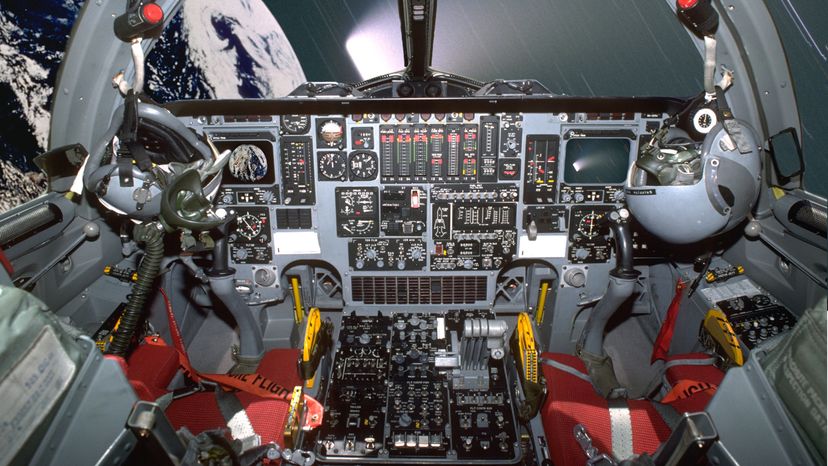
The two Voyage spacecraft certainly have had an amazing track record. They were sent to photograph planets like Jupiter, Saturn and Neptune and have just kept on going past the outer edge of the solar system. Voyager 1 is currently over 7 billion miles (about 11 billion kilometers) away from Earth and is still transmitting -- it takes about 10 hours for the signal to travel from the spacecraft to Earth!
The Voyager spacecraft use 23-watt radios. This is higher than the 3 watts a typical cell phone uses, but in the grand scheme of things it is still a low-power transmitter. Big radio stations on Earth transmit at tens of thousands of watts and they still fade out fairly quickly.
The key to receiving the signals is therefore not the power of the radio, but a combination of three other things:
- Very large antennas
- Directional antennas that point right at each other
- Radio frequencies without a lot of man-made interference on them
The antennas that the Voyager spacecraft use are big. You may have seen people who have large satellite dish antennas in their yards. These are typically 2 or 3 meters (6 to 10 feet) in diameter. The Voyager spacecraft has an antenna that is 3.7 meters (14 feet) in diameter, and it transmits to a 34 meter (100 feet or so) antenna on Earth. The Voyager antenna and the Earth antenna are pointed right at each other. When you compare your phone's stubby, little omni-directional antenna to a 34 meter directional antenna, you can see the main thing that makes a difference!
The Voyager satellites are also transmitting in the 8 GHz range , and there is not a lot of interference at this frequency. Therefore the antenna on Earth can use an extremely sensitive amplifier and still make sense of the faint signals it receives. Then when the earth antenna transmits back to the spacecraft, it uses extremely high power (tens of thousands of watts) to make sure the spacecraft gets the message.
Frequently Asked Questions
What role do earth's ground stations play in receiving signals from distant spacecraft like voyager, how has technology advanced to maintain communication with voyager as it moves further away.
Please copy/paste the following text to properly cite this HowStuffWorks.com article:
The Voyager "Sounds of Earth" Record contains sounds and images selected to portray the diversity of life and culture on Earth that went with the Voyager spacecraft launched in 1977. Selected by a committee chaired by Carl Sagan, it contained 122 images, spoken greetings in fifty-five languages, and music.
This duplicate record was transferred from the National Aeronautics and Space Administration to the Museum in 1978.
The Voyager "Sounds of Earth" record is an analogue disc record containing sounds and images selected to portray the diversity of life and culture on Earth, attached to the Voyager 1 and Voyager 2 spacecraft.
When the Voyager spacecraft launched in 1977 to explore the outer Solar System both carried identical messages to any form of life that might be encountered. The message was contained on a phonograph record--a 12-inch gold-plated copper disk containing sounds and images selected to portray the diversity of life and culture on Earth. The contents of the record were selected for NASA by a committee chaired by Carl Sagan of Cornell University. Dr. Sagan and his associates assembled 122 images and a variety of natural sounds. To this they added spoken greetings from Earth in fifty-five languages. There is also an eclectic 90-minute musical program, in which Chuck Berry’s "Johnny B Goode" and Mozart’s "Magic Flute" vie with a Zairian Pygmy girls’ initiation song, a shakuhachi piece from Japan and "Dark Was the Night," written and performed by Blind Willie Johnson.
The disc was mounted in plain view on the exterior of both Voyager spacecraft, along with a stylus and pictographic instructions on how to play it. The side that faces inward towards the spacecraft is best protected, and contains all the images included on the record, as well as human and cetacean greetings, the sounds of Earth, and a third of the music selections. The outer side consists entirely of musical selections.
This object is not on display at the National Air and Space Museum. It is either on loan or in storage.
- Get Involved
- Host an Event
Thank you. You have successfully signed up for our newsletter.
Error message, sorry, there was a problem. please ensure your details are valid and try again..
- Free Timed-Entry Passes Required
- Terms of Use
After months of silence, Voyager 2 sends a gleeful message back to Earth
11.5 billion miles away from Earth, the intrepid spacecraft finally got a call from NASA after months of radio silence.
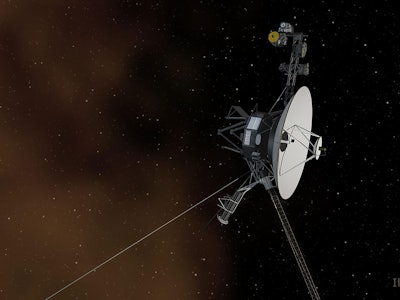
After months of the silent treatment , NASA has finally reconnected with one of its longest running missions.
The Voyager 2 spacecraft has been roaming the cosmos for more than 40 years, all the while staying in touch with a diligent team of engineers in ground control. But in March of this year, NASA hung up the line.
The space agency left the spacecraft to spend a lonely few months in space in order to upgrade their communication system. Flying some 11.5 billion miles away from Earth, Voyager 2 was left to its own devices in mid-March.
But on October 29, NASA briefly reconnected. And, thankfully, Voyager 2 gleefully answered the call.
Voyager 2 is a vital scientific mission and one of the furthest manmade objects from Earth — so far it has left the Solar System entirely. To communicate with the spacecraft, NASA relies on a system called the Deep Space Network (DSN) antennas .
The system came to be when NASA launched its first ever satellite, Explorer 1, in 1958. The DSN is used to communicate with an average of 30 spacecraft every day. It runs 24 hours a day, 365 days a year, and is spread out across three sites in the United States, Australia, and Spain.
The DSN is reliable. But it is also more than 70 years old.
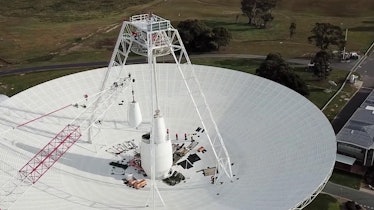
Engineers got to work, upgrading the radio antenna Deep Space Station 43 in Canberra, Australia.
As the space agency gears up for a slew of new missions to the Moon and Mars , all launching in the next few years, the DSN is due for a much needed upgrade.
NASA started this crucial work with an antenna dubbed Dss43. It is 230-feet-wide, about the size of a 20-story building, and is located in Canberra, Australia.
Dss43 has been operational for 48 years — and some of its parts, including the transmitter used to communicate with Voyager 2, had never been upgraded.
But to safeguard the antenna's next four decades of service (hopefully), NASA has upgraded Dss43's heating and cooling equipment, power supply equipment, and other electronics.
Friday's brief call to Voyager 2 was the first test of the new equipment.
"What makes this task unique is that we're doing work at all levels of the antenna, from the pedestal at ground level all the way up to the feedcones at the center of the dish that extend above the rim," Brad Arnold, the DSN project manager at NASA's Jet Propulsion Lab in Southern California, said in a statement . "This test communication with Voyager 2 definitely tells us that things are on track with the work we're doing."
In the test, NASA's mission operators sent a series of commands to Voyager 2 for the first time since the radio antenna went offline in mid-March, and the spacecraft confirmed that it had received the signal and went on to execute the commands.
Unfortunately for the lonely craft, NASA is going to hang up the line again. Dss43 will not be fully back online until February, 2021. Voyager 2 will have to face a few more months alone. That's worrying for the mission's engineers on the ground, too.
"Having the antenna down for one year is not an ideal situation for Voyager or for many other NASA missions," Philip Baldwin, operations manager for NASA's Space Communications and Navigation (SCaN) Program, said in statement. "The agency made the decision to conduct these upgrades to ensure that the antenna can continue to be used for current and future missions. For an antenna that is almost 50 years old, it's better to be proactive than reactive with critical maintenance."
In January 2020, Voyager 2 suffered a slight glitch , when its software shut down one of its science instruments unexpectedly. NASA’s ground team of engineers worked round the clock to get the spacecraft up and running to its normal operations once again by sending commands up to the craft. Because of its distance, each command took about 17 hours to reach Voyager 2. With no communication line, any fault with the craft that occurs during the downtime would be missed.
Voyager 2 is on a joint mission with another craft, Voyager 1, to provide scientists with a unique view of our own Solar System, looking at it from the outside in.
Both spacecraft began their journey in 1977, and the speedier twin Voyager 1 made the jump into interstellar space in 2011, before it was followed by Voyager 2 in 2018 .
Initial results from the mission published in the journal Nature in November, 2019 describe how the craft have given scientists a pretty good idea of the shape of the heliosphere — the bubble that the Sun forms around itself and separates it from outer space.
The mission still has about five years left in its designated timeline.
- Space Science
Voyager 1 briefly came back to life after a 'poke' from NASA, giving scientists hope for the 46-year-old probe
- NASA engineers may have found a clever trick to get Voyager 1 talking in ways engineers understand.
- The probe, showing its age, has been sending back garbled data since November.
- Engineers sent a "poke" to the aged probe and received a surprising response.

Voyager 1 has taken to improvising in its old age, making it very difficult to understand what it has to say.
The probe has sent back a steady flow of gibberish since November, worrying scientists trying to capture the final slivers of information from the 46-year-old spacecraft.
Undeterred, NASA engineers have been working to rescue the data. A "poke" sent to Voyager 1's internal systems on March 3 may have brought it back from the brink, NASA announced on Wednesday.
NASA engineers spotted an unusual dataset in the response to their prompt. This may hold the key to deciphering the spacecraft's cryptic signal, the agency said.
The Voyager 1 and Voyager 2 probes have been feeding data about our universe since the late '70s when NASA first launched them.
They remain marvels of engineering — no one expected them to survive longer than five years. But they have continued to send back information about the cosmos, exceeding their lifespan more than nine times over.
Voyager 1 and Voyager 2 hold unique positions in space-exploration history as the only spacecraft to have ventured into interstellar space. Each spacecraft is more than 10 billion miles away from Earth and getting farther every day.
Related stories
While their instruments are feeling the weight of their age, NASA has managed to continue squeezing information out of the spacecraft with clever engineering tricks.
This approach has provided an unprecedented glimpse into what happens beyond the sun's reach.
"That's what's most important is keeping these spacecraft operating as long as possible," Suzanne Dodd, NASA's project manager for Voyager, told Business Insider in January.
The glitch in Voyager 1 data is hardly unexpected. It is only the latest in a series of issues in the probes' systems NASA has had to tackle. Experts have been concerned that repeat malfunctions are signs the probes are entering the last moments of their functional lives.
But NASA appears to have found a solution. Engineers knew Voyager 1's issue seemed to lie with one of the three on-board computers that package the probe's data before sending it to Earth — the flight-data subsystem, or FDS.
The ping to the FDS on March 1 returned a mostly muddled signal on March 3, but it contained some data that "differed from the rest of the computer's unreadable data stream."
One NASA engineer with its Deep Space Network decoded this precious signal, unlocking a "readout" of the FDS's memory that contains instructions and variables the engineers can use to understand what went wrong.
This doesn't mean all is saved.
"The team is analyzing the readout. Using that information to devise a potential solution and attempt to put it into action will take time," NASA said.
Regardless of what happens, the probes' final missions will continue.
Even when they can no longer communicate with Earth, Voyager 1 and Voyager 2 will continue to drift through the galaxy, carrying golden records with information about humanity.
The hope is that these could act as interstellar messages for potential intelligent life that may intercept the iconic spacecraft.
- Main content
- Mon compte Mon profil Déconnexion
Sciences et Avenir Espace Voie lactée
Voyager 1 : réparée, la sonde poursuit sa mission au-delà du système solaire
Par Joël Ignasse le 01.09.2022 à 12h14 Ecouter 3 min.
L'engin le plus éloigné de la Terre rencontrait depuis le mois de mai 2022 quelques soucis techniques. La cause de l'avarie a enfin été identifiée et corrigée.

L'antenne grand gain de la sonde, au centre, est contrôlée par l'instrument AACS qui a connu des défaillances.

45 ans après son lancement, la sonde Voyager 1 envoyait vers la Terre des données de télémétrie totalement incohérentes comme si elles étaient choisies de manière aléatoire : elles ne correspondaient à aucune configuration possible de l'engin. La panne semblait provenir d'un petit instrument, l'AACS : l'Attitude and Articulation Control Subsystem, un petit bloc de 20 cm sur 40, chargé de contrôler l'orientation du vaisseau et surtout de garder la grande antenne de la sonde pointée vers la Terre, afin que le contact ne soit pas rompu.
Mauvais routage des messages
Après plusieurs semaines d'investigations, les ingénieurs en charge de la sonde ont réussi à identifier l'origine de la panne. L'AACS a commencé à faire transiter les données de télémétrie via un ordinateur de bord connu pour avoir cessé de fonctionner correctement il y a des années, et l'ordinateur a corrompu les informations. Il a donc suffi d'ordonner à l'instrument de reprendre l'envoi des données vers le bon ordinateur. En revanche, la raison pour laquelle l'AACS a brusquement choisi un autre ordinateur reste mystérieuse. Il a probablement reçu une commande erronée générée par un autre ordinateur de bord. Si tel est le cas, cela indiquerait qu'il y a un problème ailleurs sur le vaisseau spatial. L'équipe continuera de rechercher ce problème sous-jacent, mais elle ne pense pas qu'il s'agisse d'une menace pour la santé à long terme de Voyager 1.
Good news: Engineers have fixed the issue that, earlier this year, caused my attitude control system data to come back garbled. The team has declared me healthy, which is great, because I still have more interstellar exploring to do! More at https://t.co/lzaY0bgcAT — NASA Voyager (@NASAVoyager) August 30, 2022
45 ans et toujours utiles
Les sondes Voyager 1 et Voyager 2 ont été lancées en 1977, et toutes deux voguent désormais en dehors d'une des limites du système solaire, au-delà de la bulle de gaz et de particules produites par notre étoile. Elles ont franchi l'héliopause, cette frontière dynamique dont la distance et la composition peuvent subir des variations en fonction de l'activité du Soleil respectivement en août 2012 pour Voyager 1 et en novembre 2018 pour Voyager 2. Elles évoluent depuis dans le milieu interstellaire, un gaz composé de noyaux atomiques et de particules formés par les explosions d'autres étoiles. Voyager 1 est la plus éloignée des deux engins : elle évolue à 23,5 milliards de km de la Terre tandis que sa consœur vogue à 19,5 milliards de km. A cette distance, il est particulièrement difficile de communiquer avec elles puisque les messages mettent une vingtaine d'heure à parvenir à destination.
Exploration spatiale Sonde Voyager 1 Sonde Voyager 2
- Une galaxie sans étoiles découverte par hasard
- Du givre trouble la vision du télescope spatial européen Euclid
- "Notre objectif est de recueillir la lumière de 40 millions de galaxies"

- La Maison Blanche demande à la Nasa d'établir un temps lunaire de référence
- 3e tentative de lancement du Starship de SpaceX, la fusée conçue pour Mars
- Au Japon, une fusée de la société privée Space One explose au décollage

- Eclipse de Soleil : quand aura lieu la prochaine en Europe, et en France ?
- Eclipse solaire : attention danger pour les yeux
- Eclipse de Soleil du 8 avril 2024 : où, quand et comment l'observer ?
- Qui enverra son rover sur la Lune ?

- Des étoiles zombies autour du trou noir central de la Voie lactée
- "L'énergie noire pourrait avoir évolué au fil du temps"
- Les petites étoiles tremblent aussi
- Hubble observe une étoile se dévoiler

Accepter et continuer
Centre de préférence de vos alertes infos
Vos préférences ont bien été enregistrées.
Si vous souhaitez modifier vos centres d'intérêt, vous pouvez à tout moment cliquer sur le lien Notifications, présent en pied de toutes les pages du site.
Vous vous êtes inscrit pour recevoir l’actualité en direct, qu’est-ce qui vous intéresse?
Je souhaite recevoir uniquement les alertes infos parmi les thématiques suivantes :

Victor Mukhin
- Scientific Program


Title : Active carbons as nanoporous materials for solving of environmental problems
However, up to now, the main carriers of catalytic additives have been mineral sorbents: silica gels, alumogels. This is obviously due to the fact that they consist of pure homogeneous components SiO2 and Al2O3, respectively. It is generally known that impurities, especially the ash elements, are catalytic poisons that reduce the effectiveness of the catalyst. Therefore, carbon sorbents with 5-15% by weight of ash elements in their composition are not used in the above mentioned technologies. However, in such an important field as a gas-mask technique, carbon sorbents (active carbons) are carriers of catalytic additives, providing effective protection of a person against any types of potent poisonous substances (PPS). In ESPE “JSC "Neorganika" there has been developed the technology of unique ashless spherical carbon carrier-catalysts by the method of liquid forming of furfural copolymers with subsequent gas-vapor activation, brand PAC. Active carbons PAC have 100% qualitative characteristics of the three main properties of carbon sorbents: strength - 100%, the proportion of sorbing pores in the pore space – 100%, purity - 100% (ash content is close to zero). A particularly outstanding feature of active PAC carbons is their uniquely high mechanical compressive strength of 740 ± 40 MPa, which is 3-7 times larger than that of such materials as granite, quartzite, electric coal, and is comparable to the value for cast iron - 400-1000 MPa. This allows the PAC to operate under severe conditions in moving and fluidized beds. Obviously, it is time to actively develop catalysts based on PAC sorbents for oil refining, petrochemicals, gas processing and various technologies of organic synthesis.
Victor M. Mukhin was born in 1946 in the town of Orsk, Russia. In 1970 he graduated the Technological Institute in Leningrad. Victor M. Mukhin was directed to work to the scientific-industrial organization "Neorganika" (Elektrostal, Moscow region) where he is working during 47 years, at present as the head of the laboratory of carbon sorbents. Victor M. Mukhin defended a Ph. D. thesis and a doctoral thesis at the Mendeleev University of Chemical Technology of Russia (in 1979 and 1997 accordingly). Professor of Mendeleev University of Chemical Technology of Russia. Scientific interests: production, investigation and application of active carbons, technological and ecological carbon-adsorptive processes, environmental protection, production of ecologically clean food.
Quick Links
- Conference Brochure
- Tentative Program

Foreign Service Messages
From Kabul to Nairobi – My Risky Assignments in the Pioneering Age of Radio & Security
Conversations About Am Embassy Moscow | Secret Tunnels & Microwave Radiation
1978: the shepheard hotel bar, cairo egypt.
I sat on a stool at the Shepheard Bar and digested what Regional Security Officer Childress had told me about the Soviets radiating our embassy in Moscow with microwave energy. While Childress went to the restroom I came to the conclusion that the only reason why he would bring this up was to recruit me on the SY technical team.
<feature photo: SY tech officer crawls out from a chimney at the U.S. Embassy in Moscow in 1978 (courtesy US Department of State)
“Another beer?” Childress said as he hopped on the stool next to me.
The bartender knew the RSO’s subtle signal to order.
“Where were we?” Childress said.
“I think the Soviets were in the process of sterilizing the U.S. Embassy Moscow staff with microwave radiation.”
He gave me a double take and said, “Good one,” with the makings of a smile.
“Just kidding,” I said when he added a questioning gaze. “That amount of radiation probably… I mean… it wouldn’t cause damage to the precious… to the vital organs. You said the congressional study indicated no risk.”
I was beginning to sound like Brig. General Jack Ripper in Dr. Strangelove. That role, of course, had to belong to RSO Childress. I got back on course with, “So you were saying that SY tech support found an antenna in a U.S. Embassy chimney and the tunnel beneath it that led to another building.”
The bartender slid two more Stella draught beers in front of us. Childress used the pause to take a swig and gather his thoughts.
“First the Soviets hit us with TUMS, then SMUT-1 and SMUT-2. Now a mysterious fire. It’s time to take definitive action.”
It sounded funny, but I knew it was no laughing matter. I had already gone out to the edge with my “sterilization” comment.
Childress rotated his head, lifted his shoulders and took in a heavy breath of the Shepherd Bar air before he continued.
The Am Embassy Moscow Fire
“In August of last year, a mysterious fire broke out at the embassy in Moscow. The fire engulfed the entire ECON section on the eighth floor. It soon spread to the ninth and tenth floors and the attic. Although policy dictated otherwise, the ambassador gave permission to the Soviet fire fighters to enter the eighth floor.”
Childress paused to get my take.
“No shit?” I said.
“Later Soviet firemen were allowed to fight the fire from aerial ladders when it broke through the chancery’s roof. Although the ambassador denied the Soviets access to the tenth floor, four unescorted Soviet firemen entered the classified area—the Communications and Records Office—of the ninth floor through a window.”
Childress shook his head. “We’ve got to do better at controlling these situations.”
I didn’t have anything add to that.
The Soviets backed off when they saw a Defense Attaché́ officer aiming a camera at them. The embassy chancery offices and the roof suffered extensive damage. Fortunately, the RSO concluded that sensitive equipment and records had not been compromised.”
I had to cut to the chase. The Marine Guard TGIF party had already begun an hour ago. “Is this related to the antenna in the chimney at the American embassy there?”
Childress turned to me and with a bold expression said, “Most assuredly. That’s all I can say at the moment.” While continuing to gaze at me he added, “I guess you’re wondering why I’m telling you all of this.”
“It crossed my mind.”
“I must remind you that this is all confidential.”
“Understood.”
I followed his lead and quaffed a few ounces out of the flagon of Stella beer.
A Recruiter’s “Pitch”
“I’ve been impressed by your work here.”
Here we go. “Thanks.”
“You’ve probably figured out that we may need some help in Moscow on the technical side identifying these microwave radiation issues. As I mentioned earlier I’ll be heading to Moscow after I return from home leave. We anticipate the assignment duration will be about three months. In the meantime SY is putting together a team.”
Childress paused to let that sink in.
“Think you might be interested in joining the team?”
What about my radio cohort Al back at the RCO office in Karachi? He depended on me to handle all the fieldwork. Three months? I bet it would be more like six months. Or it could be an indeterminate time period. OC/PE-R could reassign me Moscow for two years.
“Why don’t you return to Karachi and talk to RCO Roberson about it? It would be for the good of the Foreign Service you know.”
I said, “I appreciate your offer, but I’m going to have to respectfully decline.”
His expression told me that Childress didn’t take too kindly that I had not even considered his offer.
To further explain my response I said, “I’m new in the Foreign Service. This is my first assignment overseas. If I had a few years experience under my belt I’d probably say, ‘Sure, I’ll take up your offer.’”
His expression changed from put off to disappointed.
“We’re responsible for over sixty missions out of the RCO radio office in Karachi. There’s only two of us. I’ve got a lot of people over here counting on me. This area has been neglected for quite a while. Can I make a suggestion?”
“Sure, go ahead,” he said in a discouraged tone.
“Senior CEO Norm Bates helped you guys out in South America. I suggest you contact him. He’s about the best we’ve got and he’s currently back at SECSTATE.”
“We’ve already contacted him. He’s got health issues.”
“Oh, sorry to hear it.”
Would Norm’s gout hold him back?
“You know, there’s some sharp radio techs back at the department awaiting assignments…”
“What is it?” Childress said.
Zoom Zoom, our super-sleuth radio tech would be the perfect guy for the job.
“CEO Parker is a recent hire back at OC/R. I think he would be a good fit for the Moscow assignment.”
Childress chugged the remainder of the beer, glanced at his watch, and said, “We’ll consider CEO Parker. In the meantime, if you reconsider send me a message.”
He gaged my expression and said, “I’m sure they’ll be numerous perks upon completion of the assignment.”
I didn’t ask about the perks.
RSO Childress tapped the bar top and said, “I’ve got to go pack. The wife’s got big plans for me back home.”
“Have a good trip,” I said. “Sorry I wasn’t able to help you out.”
He gave me an expression that hinted that he wasn’t so sure about that, which made me nervous.
RSO Childress paid the bill, rose off the stool, and said, “See ya around.”
“Yeah, the Cairo upgrades will take a few days to complete. I’ll message you and Bob [my boss in Karachi, RCO Robert Roberson] when I finish.”
“Keep up the good work.”
“Thanks, I will.”
I hoped that was the last I ever heard of TUMS and SMUT and the U.S. Embassy in Moscow.
Share this:
Leave a comment cancel reply.

- Already have a WordPress.com account? Log in now.
- Subscribe Subscribed
- Copy shortlink
- Report this content
- View post in Reader
- Manage subscriptions
- Collapse this bar
- Vacation Rentals
- Restaurants
- Things to do
- Elektrostal Tourism
- Elektrostal Hotels
- Elektrostal Bed and Breakfast
- Flights to Elektrostal
- Elektrostal Restaurants
- Things to Do in Elektrostal
- Elektrostal Travel Forum
- Elektrostal Photos
- Elektrostal Map
- All Elektrostal Hotels
- Elektrostal Hotel Deals
- Elektrostal Hostels
- Elektrostal Business Hotels
- Elektrostal Family Hotels
- Elektrostal Spa Resorts
- 3-stars Hotels in Elektrostal
- Elektrostal Hotels with Banquet hall
- Elektrostal Hotels with Game room
- Hotels near Electrostal History and Art Museum
- Hotels near Park of Culture and Leisure
- Hotels near Statue of Lenin
- Hotels near Museum and Exhibition Center
- Hotels near Museum of Labor Glory
- Hotels near (ZIA) Zhukovsky International Airport
- Hotels near (VKO) Vnukovo Airport
- Hotels near (DME) Domodedovo Airport
- Disney's Caribbean Beach Resort
- Xafira Deluxe Resort & Spa
- Excalibur Hotel & Casino
- Giraffe Manor
- Jules Undersea Lodge
- Aruba Ocean Villas
- Royalton Riviera Cancun
- Disney's Animal Kingdom Lodge
- Hilton Hawaiian Village Waikiki Beach Resort
- Disney's All-Star Movies Resort
- Secrets Cap Cana Resort & Spa
- Hyatt Ziva Cap Cana
- Luxor Hotel & Casino
- Grand Hyatt Baha Mar
- Ocean Casino Resort
- Popular All-Inclusive Resorts
- Popular Beach Resorts
- Popular Family Resorts
- Popular All-Inclusive Hotels
- Popular Hotels With Waterparks
- Popular Honeymoon Resorts
- Popular Luxury Resorts
- Popular All-Inclusive Family Resorts
- Popular Golf Resorts
- Popular Spa Resorts
- Popular Cheap Resorts
- All Elektrostal Restaurants
- Restaurants near Restaurant Globus
- Cafés in Elektrostal
- Chinese Restaurants in Elektrostal
- European Restaurants for Families in Elektrostal
- European Restaurants for Large Groups in Elektrostal
- European Restaurants for Lunch in Elektrostal
- Fast Food Restaurants in Elektrostal
- French Restaurants in Elektrostal
- Italian Restaurants in Elektrostal
- Japanese Restaurants in Elektrostal
- Pizza in Elektrostal
- Russian Restaurants in Elektrostal
- Seafood Restaurants in Elektrostal
- Vegetarian Restaurants in Elektrostal
- GreenLeaders
- Elektrostal
- Things to Do
- Travel Stories
- Rental Cars
- Add a Place
- Travel Forum
- Travelers' Choice
- Help Center
- Europe
- Russia
- Central Russia
- Moscow Oblast
- Elektrostal
- Elektrostal Restaurants
Restaurant Globus
Ratings and reviews, location and contact, restaurant globus, elektrostal - restaurant reviews & photos - tripadvisor.

- The Contents
- The Making of
- Where Are They Now
- Frequently Asked Questions
- Q & A with Ed Stone
golden record
Where are they now.
- frequently asked questions
- Q&A with Ed Stone
Galleries of Images Voyager Took
The Voyager 1 and 2 spacecraft explored Jupiter, Saturn, Uranus and Neptune before starting their journey toward interstellar space. Here you'll find some of those iconic images, including "The Pale Blue Dot" - famously described by Carl Sagan - and what are still the only up-close images of Uranus and Neptune.
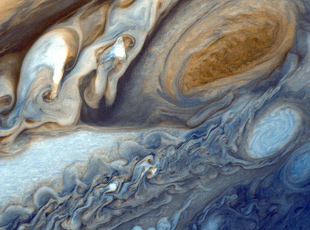
Photography of Jupiter began in January 1979, when images of the brightly banded planet already exceeded the best taken from Earth. Voyager 1 completed its Jupiter encounter in early April, after taking almost 19,000 pictures and many other scientific measurements. Voyager 2 picked up the baton in late April and its encounter continued into August. They took more than 33,000 pictures of Jupiter and its five major satellites.
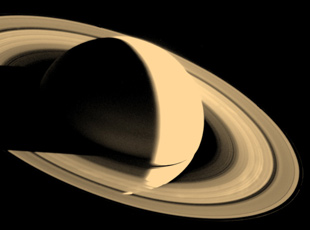
The Voyager 1 and 2 Saturn encounters occurred nine months apart, in November 1980 and August 1981. Voyager 1 is leaving the solar system. Voyager 2 completed its encounter with Uranus in January 1986 and with Neptune in August 1989, and is now also en route out of the solar system.
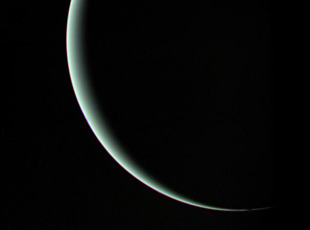
NASA's Voyager 2 spacecraft flew closely past distant Uranus, the seventh planet from the Sun, in January. At its closet, the spacecraft came within 81,800 kilometers (50,600 miles) of Uranus's cloudtops on Jan. 24, 1986. Voyager 2 radioed thousands of images and voluminous amounts of other scientific data on the planet, its moons, rings, atmosphere, interior and the magnetic environment surrounding Uranus.
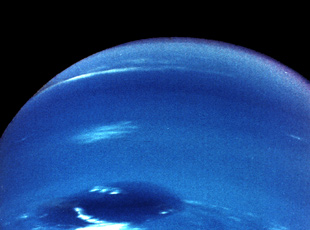
In the summer of 1989, NASA's Voyager 2 became the first spacecraft to observe the planet Neptune, its final planetary target. Passing about 4,950 kilometers (3,000 miles) above Neptune's north pole, Voyager 2 made its closest approach to any planet since leaving Earth 12 years ago. Five hours later, Voyager 2 passed about 40,000 kilometers (25,000 miles) from Neptune's largest moon, Triton, the last solid body the spacecraft will have an opportunity to study.
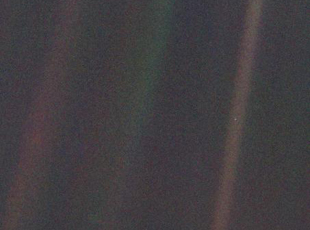
This narrow-angle color image of the Earth, dubbed 'Pale Blue Dot', is a part of the first ever 'portrait' of the solar system taken by Voyager 1. The spacecraft acquired a total of 60 frames for a mosaic of the solar system from a distance of more than 4 billion miles from Earth and about 32 degrees above the ecliptic. From Voyager's great distance Earth is a mere point of light, less than the size of a picture element even in the narrow-angle camera. Earth was a crescent only 0.12 pixel in size. Coincidentally, Earth lies right in the center of one of the scattered light rays resulting from taking the image so close to the sun. This blown-up image of the Earth was taken through three color filters -- violet, blue and green -- and recombined to produce the color image. The background features in the image are artifacts resulting from the magnification.

IMAGES
VIDEO
COMMENTS
The Voyager message is carried by a phonograph record, a 12-inch gold-plated copper disk containing sounds and images selected to portray the diversity of life and culture on Earth. Launched in 1977, both Voyager spacecraft began a historic journey and each carried a unique 'time capsule' along with them. Click to learn more.
Background. The Voyager 1 probe is currently the farthest human-made object from Earth.Both Voyager 1 and Voyager 2 have reached interstellar space, the region between stars where the galactic plasma is present. Like their predecessors Pioneer 10 and 11, which featured a simple plaque, both Voyager 1 and Voyager 2 were launched by NASA with a message aboard—a kind of time capsule, intended ...
Voyager 1 has ventured farther from Earth than any other human-made object. It was launched in 1977, within weeks of its twin spacecraft , Voyager 2. The initial aim of the mission was to explore ...
The voyager can transmit over 7 billion miles (about 11 billion kilometres) away from Earth. Philip Wallick / Getty Images. The two Voyage spacecraft certainly have had an amazing track record. They were sent to photograph planets like Jupiter, Saturn and Neptune and have just kept on going past the outer edge of the solar system. Voyager 1 is currently over 7 billion miles (about 11 billion ...
This new signal resulted from a command sent to Voyager 1 on March 1. Called a "poke" by the team, the command is meant to gently prompt the FDS to try different sequences in its software package in case the issue could be resolved by going around a corrupted section. Because Voyager 1 is more than 15 billion miles (24 billion kilometers ...
Learn about the Pioneer Plaque and Voyager Golden Record, two artifacts launched by NASA to communicate with extraterrestrial civilizations. #nasahistory #sp...
The plaque attached to Pioneer 10. The Pioneer plaques are a pair of gold - anodized aluminum plaques that were placed on board the 1972 Pioneer 10 and 1973 Pioneer 11 spacecraft, featuring a pictorial message, in case either Pioneer 10 or 11 is intercepted by intelligent extraterrestrial life. The plaques show the nude figures of a human male ...
When the Voyager spacecraft launched in 1977 to explore the outer Solar System both carried identical messages to any form of life that might be encountered. The message was contained on a phonograph record--a 12-inch gold-plated copper disk containing sounds and images selected to portray the diversity of life and culture on Earth.
Flying some 11.5 billion miles away from Earth, Voyager 2 was left to its own devices in mid-March. But on October 29, NASA briefly reconnected. And, thankfully, Voyager 2 gleefully answered the call.
Genèse du projet. Les sondes spatiales Voyager 1 et 2 s'inscrivent dans la continuité du programme Pioneer.. Les sondes Pioneer 10 et 11, lancées respectivement en 1972 et en 1973, étaient chargées d'explorer les planètes externes du Système solaire.Au terme de leur mission, leur trajectoire devant se poursuivre hors du Système solaire, il fut décidé d'y embarquer un message de l ...
This is a real-time indicator of Voyager 1's distance from Earth in astronomical units (AU) and either miles (mi) or kilometers (km). Note: Because Earth moves around the sun faster than Voyager 1 is speeding away from the inner solar system, the distance between Earth and the spacecraft actually decreases at certain times of year.
Meanwhile, Voyager 2 has traveled more than 12.6 billion miles (20.3 billion kilometers) from our planet. Both are in interstellar space and are the only spacecraft ever to operate beyond the ...
Undeterred, NASA engineers have been working to rescue the data. A "poke" sent to Voyager 1's internal systems on March 3 may have brought it back from the brink, NASA announced on Wednesday. NASA ...
Les sondes Voyager 1 et 2 explorent le système solaire depuis près d'un demi-siècle ! "Vous n'êtes pas seuls", le message gagnant pour la sonde Voyager 1 Commenter
By Adrianna Nine April 10, 2024. Credit: NASA/JPL. For months, NASA's Voyager team has been struggling to translate garbled messages from beyond our solar system. Voyager 1 has been responding to ...
Title : Active carbons as nanoporous materials for solving of environmental problems Abstract: However, up to now, the main carriers of catalytic additives have been mineral sorbents: silica gels, alumogels. This is obviously due to the fact that they consist of pure homogeneous components SiO2 and Al2O3, respectively.
1978: The Shepheard Hotel Bar, Cairo Egypt I sat on a stool at the Shepheard Bar and digested what Regional Security Officer Childress had told me about the Soviets radiating our embassy in Moscow with microwave energy. While Childress went to the restroom I came to the conclusion that the only reason why he would…
Restaurant Globus. Unclaimed. Review. Save. Share. 67 reviews #2 of 28 Restaurants in Elektrostal $$ - $$$ European Contemporary Vegetarian Friendly. Fryazevskoye Hwy., 14, Elektrostal Russia + Add phone number + Add website + Add hours Improve this listing. See all (2)
This narrow-angle color image of the Earth, dubbed 'Pale Blue Dot', is a part of the first ever 'portrait' of the solar system taken by Voyager 1. The spacecraft acquired a total of 60 frames for a mosaic of the solar system from a distance of more than 4 billion miles from Earth and about 32 degrees above the ecliptic.
Ukrainian military had 64 combat engagements with Russian forces near Synkivka of Kharkiv region, south to Terny and Vesele of Donetsk region, Klischiyivka and Andriyivka of Donetsk region, near Novobakhmutivka, Avdiyivka, Syeverne, Pervomayske and Nevelske of Donetsk region, Heorhiyivka, Pobyeda and Novomykhaylivka of Donetsk region, Staromayorske of Donetsk region, at the east bank of Dnipro ...